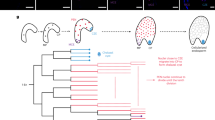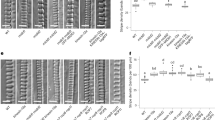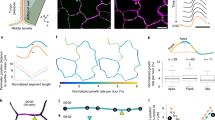Abstract
Starting as small, densely packed boxes, leaf mesophyll cells expand to form an intricate mesh of interconnected cells and air spaces, the organization of which dictates the internal surface area of the leaf for light capture and gas exchange during photosynthesis. Despite their importance, little is known about the basic patterns of mesophyll cell division, and how they contribute to cell and intercellular space organization. To address this, we tracked divisions within individual cell lineages in three dimensions over time in Arabidopsis spongy mesophyll. We found that early on, successive cell division planes switch their orientation such that each new cell wall intersects the previous at a right angle, creating a new multi-cell junction (the intersection of three or more cells). These junctions then open to create intercellular spaces. During subsequent enlargement of the spaces, the division planes of the surrounding cells show an increasing tendency to tilt in the direction of their adjacent intercellular spaces. This disrupts the alternating pattern, and by extension, halts the initiation of new multi-cell junctions and intercellular spaces, but allows the expansion of existing spaces. Both division patterns are specified before mitosis by the orientation of interphase cortical microtubules, which gradually narrow to form a preprophase band in the same orientation to establish the future plane of cell division. In the absence of the microtubule-associated protein CLASP, the early alternating division plane and microtubule patterns are compromised, whereas space-oriented divisions are exacerbated. This results in large distortions of the topological relations between cells and intercellular spaces, as well as changes in their relative abundance. Our data reveal the existence of two competing cell division mechanisms that are balanced by CLASP to specify the distribution of cells and intercellular spaces in spongy mesophyll tissue.
This is a preview of subscription content, access via your institution
Access options
Access Nature and 54 other Nature Portfolio journals
Get Nature+, our best-value online-access subscription
$29.99 / 30 days
cancel any time
Subscribe to this journal
Receive 12 digital issues and online access to articles
$119.00 per year
only $9.92 per issue
Buy this article
- Purchase on Springer Link
- Instant access to full article PDF
Prices may be subject to local taxes which are calculated during checkout








Similar content being viewed by others
Data availability
The plasmids, Arabidopsis lines and confocal stacks used in this study are available from the corresponding author upon request. Source data are provided with this paper.
References
Hashimoto, T. Microtubules in plants. Arabidopsis Book 13, e0179 (2015).
Lloyd, C. & Chan, J. Microtubules and the shape of plants to come. Nat. Rev. Mol. Cell Biol. 5, 13–23 (2004).
Wasteneys, G. O. Microtubule organization in the green kingdom: chaos or self-order? J. Cell Sci. 115, 1345–1354 (2002).
Ehrhardt, D. W. & Shaw, S. L. Microtubule dynamics and organization in the plant cortical array. Annu. Rev. Plant Biol. 57, 859–875 (2006).
Wasteneys, G. O. & Ambrose, J. C. Spatial organization of plant cortical microtubules: close encounters of the 2D kind. Trends Cell Biol. 19, 62–71 (2009).
Baskin, T. I. Anisotropic expansion of the plant cell wall. Annu. Rev. Cell Dev. Biol. 21, 203–222 (2005).
Paradez, A., Wright, A. & Ehrhardt, D. W. Microtubule cortical array organization and plant cell morphogenesis. Curr. Opin. Plant Biol. 9, 571–578 (2006).
Peaucelle, A., Wightman, R. & Höfte, H. The control of growth symmetry breaking in the Arabidopsis hypocotyl. Curr. Biol. 25, 1746–1752 (2015).
Mineyuki, Y. in International Review of Cytology Vol. 187 (ed. Jeon, K. W.) 1–49 (Elsevier, 1999).
Ambrose, J. C. & Cyr, R. Mitotic spindle organization by the preprophase band. Mol. Plant 1, 950–960 (2008).
Chan, J., Calder, G., Fox, S. & Lloyd, C. Localization of the microtubule end binding protein EB1 reveals alternative pathways of spindle development in Arabidopsis suspension cells. Plant Cell 17, 1737–1748 (2005).
Livanos, P. & Müller, S. Division plane establishment and cytokinesis. Annu. Rev. Plant Biol. 70, 239–267 (2019).
Müller, S. Universal rules for division plane selection in plants. Protoplasma 249, 239–253 (2012).
Rasmussen, C. G., Wright, A. J. & Müller, S. The role of the cytoskeleton and associated proteins in determination of the plant cell division plane. Plant J. 75, 258–269 (2013).
Müller, S., Wright, A. J. & Smith, L. G. Division plane control in plants: new players in the band. Trends Cell Biol. 19, 180–188 (2009).
Besson, S. & Dumais, J. Universal rule for the symmetric division of plant cells. Proc. Natl Acad. Sci. USA 108, 6294–6299 (2011).
Carter, R., Sanchez-Corrales, Y. E., Hartley, M., Grieneisen, V. A. & Maree, A. F. M. Pavement cells and the topology puzzle. Development 144, 4386–4397 (2017).
Louveaux, M., Julien, J.-D., Mirabet, V., Boudaoud, A. & Hamant, O. Cell division plane orientation based on tensile stress in Arabidopsis thaliana. Proc. Natl Acad. Sci. USA 113, E4294–E4303 (2016).
Reddy, G. V. Real-time lineage analysis reveals oriented cell divisions associated with morphogenesis at the shoot apex of Arabidopsis thaliana. Development 131, 4225–4237 (2004).
Shapiro, B. E., Tobin, C., Mjolsness, E. & Meyerowitz, E. M. Analysis of cell division patterns in the Arabidopsis shoot apical meristem. Proc. Natl Acad. Sci. USA 112, 4815–4820 (2015).
Yoshida, S. et al. Genetic control of plant development by overriding a geometric division rule. Dev. Cell 29, 75–87 (2014).
MacAdam, J. W., Volenec, J. J. & Nelson, C. J. Effects of nitrogen on mesophyll cell division and epidermal cell elongation in tall fescue leaf blades. Plant Physiol. 89, 549–556 (1989).
Pyke, K. A., Marrison, J. L. & Leech, A. M. Temporal and spatial development of the cells of the expanding first leaf of Arabidopsis thaliana (L.) Heynh. J. Exp. Bot. 42, 1407–1416 (1991).
Dorca-Fornell, C. et al. Increased leaf mesophyll porosity following transient retinoblastoma-related protein silencing is revealed by microcomputed tomography imaging and leads to a system-level physiological response to the altered cell division pattern. Plant J. 76, 914–929 (2013).
Jeffree, C. E., Dale, J. E. & Fry, S. C. The genesis of intercellular spaces in developing leaves of Phaseolus vulgaris L. Protoplasma 132, 90–98 (1986).
Kolloffel, C. & Linssen, P. W. T. The formation of intercellular spaces in the cotyledons of developing and germinating pea seeds. Protoplasma 120, 12–19 (1984).
Zhang, L., McEvoy, D., Le, Y. & Ambrose, C. Live imaging of microtubule organization, cell expansion, and intercellular space formation in Arabidopsis leaf spongy mesophyll cells. Plant Cell 33, 623–641 (2021).
Gunning, B. E. S. & Sammut, M. Rearrangements of microtubules involved in establishing cell-division planes start immediately after DNA-synthesis and are completed just before mitosis. Plant Cell 2, 1273–1282 (1990).
Hamant, O. et al. Developmental patterning by mechanical signals in Arabidopsis. Science 322, 1650–1655 (2008).
Kimata, Y. et al. Cytoskeleton dynamics control the first asymmetric cell division in Arabidopsis zygote. Proc. Natl Acad. Sci. USA 113, 14157–14162 (2016).
Rasmussen, C. G. & Bellinger, M. An overview of plant division-plane orientation. New Phytol. 219, 505–512 (2018).
Ambrose, C., Allard, J. F., Cytrynbaum, E. N. & Wasteneys, G. O. A CLASP-modulated cell edge barrier mechanism drives cell-wide cortical microtubule organization in Arabidopsis. Nat. Commun. 2, 430 (2011).
Chakrabortty, B. et al. A plausible microtubule-based mechanism for cell division orientation in plant embryogenesis. Curr. Biol. 28, 3031–3043.e2 (2018).
Ruan, Y. et al. The microtubule-associated protein CLASP sustains cell proliferation through a brassinosteroid signaling negative feedback loop. Curr. Biol. 28, 2718–2729.e5 (2018).
Bichet, A., Desnos, T., Turner, S., Grandjean, O. & Höfte, H. BOTERO1 is required for normal orientation of cortical microtubules and anisotropic cell expansion in Arabidopsis. Plant J. 25, 137–148 (2001).
Kawamura, E. et al. MICROTUBULE ORGANIZATION 1 regulates structure and function of microtubule arrays during mitosis and cytokinesis in the Arabidopsis root. Plant Physiol. 140, 102–114 (2006).
Burk, D. H., Liu, B., Zhong, R., Morrison, W. H. & Ye, Z. H. A katanin-like protein regulates normal cell wall biosynthesis and cell elongation. Plant Cell 13, 807–827 (2001).
Gallagher, K. & Smith, L. G. Roles for polarity and nuclear determinants in specifying daughter cell fates after an asymmetric cell division in the maize leaf. Curr. Biol. 10, 1229–1232 (2000).
Buschmann, H. et al. Microtubule-associated AIR9 recognizes the cortical division site at preprophase and cell-plate insertion. Curr. Biol. 16, 1938–1943 (2006).
Walker, K. L., Müller, S., Moss, D., Ehrhardt, D. W. & Smith, L. G. Arabidopsis TANGLED identifies the division plane throughout mitosis and cytokinesis. Curr. Biol. 17, 1827–1836 (2007).
Azimzadeh, J. et al. Arabidopsis TONNEAU1 proteins are essential for preprophase band formation and interact with centrin. Plant Cell 20, 2146–2159 (2008).
Traas, J. et al. Normal differentiation patterns in plants lacking microtubular preprophase bands. Nature 375, 676–677 (1995).
Gilliland, L. U., Pawloski, L. C., Kandasamy, M. K. & Meagher, R. B. Arabidopsis actin gene ACT7 plays an essential role in germination and root growth. Plant J. 33, 319–328 (2003).
Louveaux, M. & Hamant, O. The mechanics behind cell division. Curr. Opin. Plant Biol. 16, 774–779 (2013).
Belteton, S. A. et al. Real-time conversion of tissue-scale mechanical forces into an interdigitated growth pattern. Nat. Plants 7, 826–841 (2021).
Bidhendi, A. J., Altartouri, B., Gosselin, F. P. & Geitmann, A. Mechanical stress initiates and sustains the morphogenesis of wavy leaf epidermal cells. Cell Rep. 28, 1237–1250.e6 (2019).
Sampathkumar, A. et al. Subcellular and supracellular mechanical stress prescribes cytoskeleton behavior in Arabidopsis cotyledon pavement cells. eLife 3, e01967 (2014).
Panteris, E. & Galatis, B. The morphogenesis of lobed plant cells in the mesophyll and epidermis: organization and distinct roles of cortical microtubules and actin filaments: research review. New Phytol. 167, 721–732 (2005).
Ambrose, C. et al. CLASP interacts with sorting nexin 1 to link microtubules and auxin transport via PIN2 recycling in Arabidopsis thaliana. Dev. Cell 24, 649–659 (2013).
Halat, L., Gyte, K. & Wasteneys, G. The microtubule-associated protein CLASP is translationally regulated in light-dependent root apical meristem growth. Plant Physiol. 184, 2154–2167 (2020).
Al-Bassam, J. & Chang, F. Regulation of microtubule dynamics by TOG-domain proteins XMAP215/Dis1 and CLASP. Trends Cell Biol. 21, 604–614 (2011).
Goodson, H. V. & Jonasson, E. M. Microtubules and microtubule-associated proteins. Cold Spring Harb. Perspect. Biol. 10, a022608 (2018).
Hamada, T. Microtubule organization and microtubule-associated proteins in plant cells. Int. Rev. Cell Mol. Biol. 312, 1–52 (2014).
Maiato, H., Khodjakov, A. & Rieder, C. L. Drosophila CLASP is required for the incorporation of microtubule subunits into fluxing kinetochore fibres. Nat. Cell Biol. 7, 42–47 (2005).
Bratman, S. V. & Chang, F. Stabilization of overlapping microtubules by fission yeast CLASP. Dev. Cell 13, 812–827 (2007).
Ambrose, J. C., Shoji, T., Kotzer, A. M., Pighin, J. A. & Wasteneys, G. O. The Arabidopsis CLASP gene encodes a microtubule-associated protein involved in cell expansion and division. Plant Cell19, 2763–2775 (2007).
Kirik, V. et al. CLASP localizes in two discrete patterns on cortical microtubules and is required for cell morphogenesis and cell division in Arabidopsis. J. Cell Sci. 120, 4416–4425 (2007).
Schaefer, E. et al. The preprophase band of microtubules controls the robustness of division orientation in plants. Science 356, 186–189 (2017).
Eng, R. C. et al. KATANIN and CLASP function at different spatial scales to mediate microtubule response to mechanical stress in Arabidopsis cotyledons. Curr. Biol. 31, 3262–3274 (2021).
Ambrose, J. C. & Wasteneys, G. O. CLASP modulates microtubule–cortex interaction during self-organization of acentrosomal microtubules. Mol. Biol. Cell 19, 4730–4737 (2008).
Le, P. Y. & Ambrose, C. CLASP promotes stable tethering of endoplasmic microtubules to the cell cortex to maintain cytoplasmic stability in Arabidopsis meristematic cells. PLoS ONE 13, e0198521 (2018).
Hamant, O., Inoue, D., Bouchez, D., Dumais, J. & Mjolsness, E. Are microtubules tension sensors? Nat. Commun. 10, 2360 (2019).
Evert, R. F. Esau’s Plant Anatomy: Meristems, Cells, and Tissues of the Plant Body: Their Structure, Function, and Development (Wiley, 2006); https://doi.org/10.1002/0470047380
Schüepp, O. Untersuchungen über Wachstum und Formwechsel von Vegetationspunkten. Jb.Bot. 57 (1916).
Gunning, B. E. S., Hughes, J. E. & Hardham, A. R. Formative and proliferative cell divisions, cell differentiation, and developmental changes in the meristem of Azolla roots. Planta 143, 121–144 (1978).
Rudall, P. J. & Knowles, E. V. W. Ultrastructure of stomatal development in early-divergent angiosperms reveals contrasting patterning and pre-patterning. Ann. Bot. 112, 1031–1043 (2013).
Bergmann, D. C. & Sack, F. D. Stomatal development. Annu. Rev. Plant Biol. 58, 163–181 (2007).
Serna, L., Torres-Contreras, J. & Fenoll, C. Clonal analysis of stomatal development and patterning in Arabidopsis leaves. Dev. Biol. 241, 24–33 (2002).
Minc, N. & Piel, M. Predicting division plane position and orientation. Trends Cell Biol. 22, 193–200 (2012).
Le, J., Mallery, E. L., Zhang, C., Brankle, S. & Szymanski, D. B. Arabidopsis BRICK1/HSPC300 is an essential WAVE-complex subunit that selectively stabilizes the Arp2/3 activator SCAR2. Curr. Biol. 16, 895–901 (2006).
Whittington, A. T. et al. MOR1 is essential for organizing cortical microtubules in plants. Nature 411, 610–613 (2001).
Boudaoud, A. et al. FibrilTool, an imagej plug-in to quantify fibrillar structures in raw microscopy images. Nat. Protoc. 9, 457–463 (2014).
Fonck, E. et al. Effect of aging on elastin functionality in human cerebral arteries. Stroke 40, 2552–2556 (2009).
Hunter, J. D. Matplotlib: a 2D graphics environment. Comput. Sci. Eng. 9, 90–95 (2007).
Waskom, M. seaborn: statistical data visualization. J. Open Source Softw. 6, 3021 (2021).
Acknowledgements
We would like to thank D. McEvoy (University of Saskatchewan) for a critical reading of the manuscript. This work was supported by the Natural Sciences and Engineering Research Council (NSERC) Discovery Grant 298264-2009, the University of Saskatchewan new faculty start-up funds and the University of Saskatchewan Biology Department graduate student scholarships.
Author information
Authors and Affiliations
Contributions
L.Z. and C.A. conceptualized the project. L.Z. developed the methodologies and performed the experiments. L.Z. and C.A. analysed the data and wrote the manuscript. C.A. acquired the funding.
Corresponding author
Ethics declarations
Competing interests
The authors declare no competing interests.
Peer review
Peer review information
Nature Plants thanks Olivier Hamant, Markus Grebe and Bo Liu for their contribution to the peer review of this work.
Additional information
Publisher’s note Springer Nature remains neutral with regard to jurisdictional claims in published maps and institutional affiliations.
Supplementary information
Supplementary Information
Supplementary Fig. 1
Source data
Source Data Fig. 4
Statistical source data.
Source Data Fig. 5
Statistical source data.
Source Data Fig. 7
Statistical source data.
Source Data Fig. 8
Statistical source data.
Rights and permissions
About this article
Cite this article
Zhang, L., Ambrose, C. CLASP balances two competing cell division plane cues during leaf development. Nat. Plants 8, 682–693 (2022). https://doi.org/10.1038/s41477-022-01163-5
Received:
Accepted:
Published:
Issue Date:
DOI: https://doi.org/10.1038/s41477-022-01163-5



